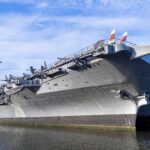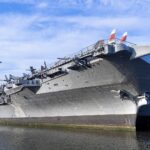A legendary piece of aviation history is about to take center stage at the Intrepid Museum: a World War II FG-1D Corsair, on loan from the National Naval Aviation Museum, courtesy of the Navy History and Heritage Command. The aircraft arrived at the museum, located in New York City, late last night, following its journey from Washington D.C. Known for its critical role in the Pacific theater, this iconic Corsair is one of the few remaining intact examples and will undergo meticulous restoration by the museum’s skilled specialists in the Aircraft Restoration Hangar. The fully restored aircraft is set to be unveiled to the public in March 2025 on the Intrepid‘s hangar deck.
Designed as a carrier-based fighter-bomber, the Corsair was essential to the U.S. Navy’s success during World War II. This particular exhibit will honor the story of Alfred Lerch, a celebrated Corsair pilot from Intrepid’s VF-10 squadron, who achieved the remarkable feat of becoming an “ace in a day” by downing seven enemy aircraft in a single combat mission. For his bravery, Lerch was awarded the Navy Cross, and the restored Corsair will bear his personal markings, making this exhibit a powerful tribute to his legacy.

Based on what was reported on Warbird Registry, this FG-1D Corsair (Bu. No. 92013), was originally delivered to the U.S. Navy in the 1940s, the Corsair began its journey in military service before transitioning into civilian hands. In 1965, it was acquired by Robert Gardner of the Damn Yankee Air Force in Hartfield, Massachusetts, and registered as N1978M. After four years, in 1969, it changed ownership to Arnold R. Tefft of Wakeman, Ohio. Sometime later, the aircraft was transferred to the U.S. Marine Corps Museum at MCAS Quantico, Virginia, where it became part of their collection. By 1975, it found a new home at the U.S. Naval Aviation Museum at NAS Pensacola, Florida. In 1979, the Corsair was loaned to the Patriots Point Development Authority in Charleston, South Carolina, before returning to the Naval Aviation Museum in 1980. Its journey continued when the aircraft was flown via helicopter lift from NAS Pensacola to Smyrna, Tennesee, in May 1980. There, it underwent an extensive rebuild by Stones River Air Service. After the restoration, it returned to the U.S. Naval Aviation Museum, where it remained from 1980 to 1985. In 1988, Bu. No. 92013 was relocated to the Washington Navy Yard, where it was suspended from the ceiling and displayed prominently as 17649, nicknamed “Big Hog.” It remained in this exhibit until 2018, preserving its legacy as a formidable World War II aircraft and an enduring symbol of naval aviation.
This new display will complement last year’s unveiling of Final Flight: The Story of a World War II Corsair, which features fragments from another Corsair that flew from Intrepid during the war. Together, the two exhibits will give visitors a deeper insight into the history, engineering, and lasting legacy of the Corsair, as well as the heroic pilots who flew them.

“Bringing this iconic Corsair to the Intrepid Museum has been a long-time goal,” said Susan Marenoff-Zausner, president of the Intrepid Museum. “It allows us to highlight the skill and bravery of Intrepid’s Corsair pilots, particularly Alfred Lerch, and furthers our mission of preserving the history of these extraordinary aircraft.”

The restoration project will focus on detailed repainting and metalwork to ensure the aircraft’s authentic appearance, complete with the markings of Lerch’s original Corsair. The restoration is expected to be completed by early March 2025.
Measuring 41 feet wide and over 33 feet long, the FG-1D Corsair was one of the most formidable aircraft of its era. Although this specific Corsair did not fly from Intrepid, Corsairs were among the most commonly flown aircraft from the ship’s flight deck during the war. Capable of reaching speeds of up to 446 mph and armed with six .50-caliber machine guns and two 1,000-pound bombs, this Goodyear-built Corsair will offer visitors a close-up look at one of World War II’s most renowned aircraft. For more information and updates on the Corsair exhibit and restoration process, please visit IntrepidMuseum.org.






































